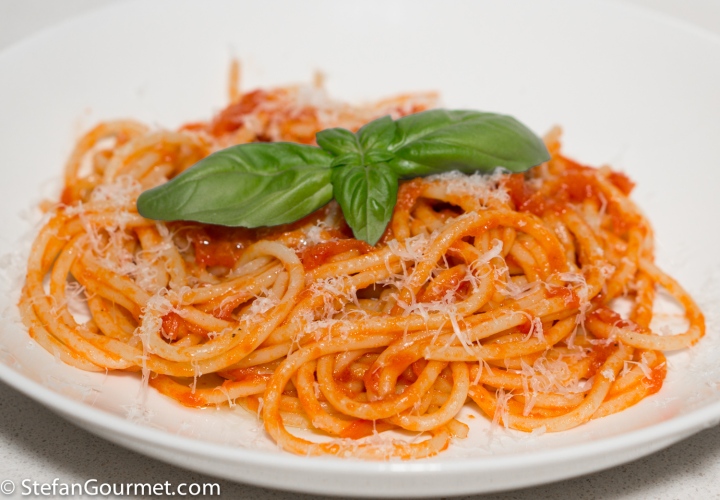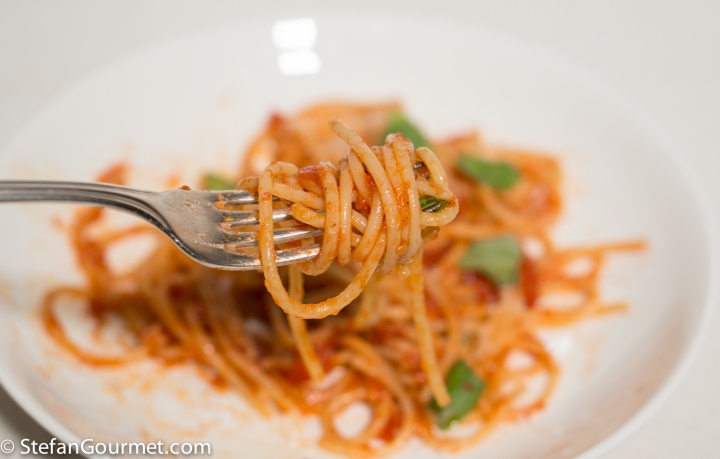Spaghetti with a sauce made from fresh tomatoes is the only dish that I prepare quite often, but has not appeared on this blog yet. There are two reasons for that: one is that I thought it wouldn’t be interesting enough for a blog post, and the other is that I am a little ashamed of the quality of the tomatoes available here. It goes without saying that for a dish as simple as this, the quality of the ingredients has to be top of the bill.
Now that the local supermarket has started to carry San Marzano tomatoes, even though they come from a greenhouse, I thought I’d share my recipe after all. And to make it more interesting, I will explain in detail about the many different techniques and ingredients for making tomato sauce. Besides fresh tomatoes, tomatoes are also available as puree, as paste, and canned. In this post I will tell you about their pros and cons, how to use them, and also about different techniques of making tomato sauce from fresh tomatoes.
Methods to make sauce from fresh tomatoes
San Marzano tomatoes are a variety of plum tomatoes from the Italian region of Campania, and considered the best to make tomato sauce because of their flavor and because they have relatively little seeds (and thus more flesh). You can also make fresh tomato sauce from other varieties of tomatoes, but you will obtain a lower yield of sauce from the same weight of tomatoes if the variety you use has more seeds. There are several ways of making tomato sauce from fresh tomatoes:
- Just cut the tomatoes into chunks and cook them in some olive oil until you obtain a saucy consistency. This is easy, but it means that your sauce will be full of pieces of skin and seeds, not very pleasant.
- Puree whole tomatoes in the food processor and then use a food mill to remove the skin and seeds, then cook low and slow in olive oil until you obtain the right consistency. This is my favorite technique if I don’t feel like skinning the tomatoes. Check out this post for more details on the technique.
- Skin the tomatoes, then puree them in the food processor, and cook them low and slow in olive oil until you obtain the right consistency. This is more work, and the seeds will still be there. You could also skin them and then sieve, but I don’t think that is worth the extra effort compared to the previous method.
- Skin the tomatoes, remove the seeds, then cut them into chunks, and cook over high heat in olive oil until you obtain the right consistency. This is my preferred method to make spaghetti al pomodoro and described in more detail below. The cooking time is very quick, just a couple of minutes, and both flavor and the slightly chunky consistency of the sauce are very nice. Removing the seeds with the liquid that surrounds them will give the sauce a different, sweeter, flavor.
- Skin the tomatoes, remove the seeds, then puree them in the food processor, and cook low and slow in olive oil until you obtain the right consistency. This yields a sauce with a smoother consistency. Check out this post for more details on the technique.
Other options to make tomato sauce
Other options to make tomato sauce (or to add tomato flavor to any sauce) are to use one of the following:
- Sieved tomatoes from a carton or a glass jar, known as passata di pomodoro in Italian or tomato puree in the USA. The quality can range from thin and watery (which will take a while to cook the right consistency) to thick and sweet (which hardly needs cooking).
- Peeled tomatoes from a can, either whole or in cubes, simply referred to as pelati in Italy. When whole I usually puree them in the food processor before using. Sometimes I use a food mill to remove the seeds and make the sauce extra smooth as described in this post.
- Tomato concentrate, also known as tomato paste, available as single, double or triple concentrate (and confusingly known as tomatenpuree in Dutch) in small cans or tubes. This is the most concentrated and is usually diluted in water or stock before using it to add tomato flavor to a sauce, for example in ragù alla bolognese. I would never make spaghetti al pomodoro using tomato concentrate as the flavor isn’t good enough on its own.
Fresh tomatoes are more complex and elegant in flavor than sieved or canned tomatoes, and tomato concentrate is the least complex. When fresh tomatoes are not available, sieved or canned are a good substitute for most recipes, but the result will be markedly different. When fresh tomatoes are watery, that is actually a good thing.
And now it’s time for the recipe.
Ingredients
For 2 servings
500 grams (1.1 lbs) ripe plum tomatoes
150 grams (.33 lb) spaghetti
1 clove garlic
2 Tbsp extra virgin olive oil
salt and freshly ground black pepper
basil for garnish (optional)
freshly grated parmigiano reggiano for garnish (optional)
Instructions
Bring a large pot of water to a boil. We will use this pot both for skinning the tomatoes and cooking the spaghetti.
With a sharp knife, make a cross in the bottom of each tomato.
When the water boils, carefully lower the tomatoes into the boiling water. Wait until you can see the skin bursting, which should take 10-20 seconds…
…and then lift the tomatoes out of the water with a strainer…

…and plunge them into cold water to stop the cooking.

Add a generous amount of salt to the boiling water.
Add the spaghetti and set the timer for the time indicated for al dente on the package of the pasta. There is no need to add olive oil to the water.
Wait until the spaghetti softens slightly, then push it under water with a wooden spoon.

Cook the spaghetti over high enough heat such that the movement of the boiling water will prevent the spaghetti from sticking together. It is still a good idea to stir it now and then.
In the meantime (you may have to wait a while before putting the spaghetti into the boiling water if your spaghetti has a short cooking time and/or when you are not very quick with the tomatoes), skin the tomatoes. The skin should come right off.
Cut the tomatoes in half crosswise.
Remove the seeds with your finger (or a small spoon).
Chop the tomatoes, but don’t forget to remove the tough bit where the stem was attached.
Heat two tablespoons olive oil in a frying pan. Add a peeled whole garlic clove, and cook it until golden on all sides, then discard. Under no circumstance should the garlic turn brown or burn, as that would ruin the flavor.
Add the chopped tomatoes and season with salt…
…and cook over high heat, stirring constantly and vigorously, until the sauce has a nice consistency. Then lower the heat. Season to taste with salt and freshly ground black pepper.
If you timed everything perfectly, the timer should beep at this point. When that happens, drain the spaghetti. Do NOT rinse it with cold water!
You could reserve a bit of the cooking water if you think the tomato sauce has become too thick, and use it to water it down if necessary.
Add the spaghetti to the pan with the tomato sauce.
Stir until the spaghetti is coated with the tomato sauce. Add a tablespoon of the reserved cooking water if needed.
Serve AT ONCE on preheated plates (pasta should never be kept waiting). It is nice to drizzle it with very good quality extra virgin olive oil…
…and to garnish with just a bit of freshly grated parmigiano reggiano and some fresh basil.
Wine pairing
My favorite wine pairing for this is a dry light rosé, such as from Provence.
Flashback
A very appropriate flashback for today is tomato risotto, which can be made with either canned tomatoes, sieved tomatoes, or fresh tomatoes.
























This post brought back some really good memories. This is one of the first sauces I learned how to cook and one of the first posts on my blog. Beautiful tomatoes and post. Thanks for sharing Stefan!
LikeLiked by 1 person
I make it the same way as you but I finish it with a knob of butter instead of olive oil. Reminds me of my childhood.
LikeLiked by 1 person
We can get the Marzanos in season here in Oz but to me they are too small to go to the bother of peeling and I do use your methodology. Passata has become hugely popular locally over the last few years and there are some quite presentable brands available at very low prices: actually for a midweek fast and fun pasta dish I almost always reach for a bottle. Thank you for your summary on the topic: a very useful one indeed 🙂 !!
LikeLiked by 1 person
This is exactly how I like my spaghetti al pomodoro! 🙂
LikeLiked by 1 person
Simple is usually best Stefan. This is as good as ‘simple’ gets.
LikeLiked by 1 person
Nothing like a simple tomato sauce. I am so glad to see you remove the skins as so many people do not and I hate bits of skin in my sauce.
LikeLiked by 1 person
Absolutely lovely! It’s good to hear you are getting better tomatoes there. 🙂
LikeLiked by 1 person
Spaghetti perfetti! Adoro la pasta al pomodoro, senza formaggio.
LikeLiked by 1 person
Yum!! You know what I love the most about Italian food? The simplest recipes are ALWAYS the best! Glad you shared this one Stefan!!
LikeLiked by 1 person
C’è poco da fare, gli spaghetti al pomodoro (con una salsa al pomodoro davvero buona) sono una vera prelibatezza! E non stancano mai!
LikeLiked by 1 person
Try to season with some orangejuice – juice from half an orange would be appropriate for this recipe. I learned the trick from an Italian Michelin star restaurant
LikeLiked by 1 person